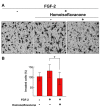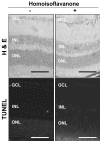Inhibition of choroidal neovascularization by homoisoflavanone, a new angiogenesis inhibitor
- PMID: 18385791
- PMCID: PMC2274926
Inhibition of choroidal neovascularization by homoisoflavanone, a new angiogenesis inhibitor
Abstract
Purpose: Age-related macular degeneration (AMD) is the leading cause of blindness in elderly. The detailed mechanism of choroidal neovascularization (CNV) leads to severe vision loss in patients with AMD. This study was undertaken to evaluate the inhibitory effect of homoisoflavanone on CNV.
Methods: Antiangiogenic activity of homoisoflavanone was evaluated by in vitro tube formation assay of human umbilical vein endothelial cells (HUVECs) and cell migration assay of HUVECs., Homoisoflavanone or PBS was injected intravitreously into a mouse model of laser-photocoagulation-induced CNV. Fluorescein angiography and vessel counting in cross sections were employed to examine CNV lesions. The toxicity of homoisoflavanone was evaluated through 3-(4,5-Dimethylthiazol-2-yl)-2,5-diphenyltetrazolium bromide assay (MTT) assay in HUVECs as well as histological examination and terminal deoxynucleotidyl transferase biotin-dUTP nick end labeling (TUNEL) staining in the retina.
Results: Homoisoflavanone effectively inhibited in vitro tube formation and cell migration of HUVECs. Interestingly, homoisoflavanone significantly reduced CNV and its leakage in a mouse model of laser-photocoagulation-induced CNV. In addition, homoisoflavanone showed no effect on cell viability of HUVECs and no retinal toxicity in a concentration range of 1-10 microM.
Conclusions: Our data suggest that homoisoflavanone is a potent inhibitor of CNV and may be applied in the treatment of other vasoproliferative retinopathies and tumor.
Figures





Similar articles
-
Antiangiogenic effect of deguelin on choroidal neovascularization.J Pharmacol Exp Ther. 2008 Feb;324(2):643-7. doi: 10.1124/jpet.107.132720. Epub 2007 Oct 29. J Pharmacol Exp Ther. 2008. PMID: 17967937
-
Inhibition of choroidal neovascularization by topical application of angiogenesis inhibitor vasostatin.Mol Vis. 2009 Sep 18;15:1897-905. Mol Vis. 2009. PMID: 19768130 Free PMC article.
-
Semaphorin 3A blocks the formation of pathologic choroidal neovascularization induced by transforming growth factor beta.Mol Vis. 2014 Sep 19;20:1258-70. eCollection 2014. Mol Vis. 2014. PMID: 25352735 Free PMC article.
-
Triptolide attenuates laser-induced choroidal neovascularization via M2 macrophage in a mouse model.Biomed Pharmacother. 2020 Sep;129:110312. doi: 10.1016/j.biopha.2020.110312. Epub 2020 Jun 16. Biomed Pharmacother. 2020. PMID: 32559620
-
Apatinib, an Inhibitor of Vascular Endothelial Growth Factor Receptor 2, Suppresses Pathologic Ocular Neovascularization in Mice.Invest Ophthalmol Vis Sci. 2017 Jul 1;58(9):3592-3599. doi: 10.1167/iovs.17-21416. Invest Ophthalmol Vis Sci. 2017. PMID: 28715845
Cited by
-
Non-invasive pharmacological advances in early retinopathy treatment: bioactive herbal compounds, polymer delivery systems, and computational bioprospecting of functional targets.Pharmacol Rep. 2025 Aug 28. doi: 10.1007/s43440-025-00778-7. Online ahead of print. Pharmacol Rep. 2025. PMID: 40866756 Review.
-
Cremastranone-Derived Homoisoflavanes Suppress the Growth of Breast Cancer Cells via Cell Cycle Arrest and Caspase-Independent Cell Death.Biomol Ther (Seoul). 2023 Sep 1;31(5):526-535. doi: 10.4062/biomolther.2023.057. Epub 2023 May 25. Biomol Ther (Seoul). 2023. PMID: 37226044 Free PMC article.
-
Natural product inhibitors of ocular angiogenesis.Exp Eye Res. 2014 Dec;129:161-71. doi: 10.1016/j.exer.2014.10.002. Epub 2014 Oct 7. Exp Eye Res. 2014. PMID: 25304218 Free PMC article. Review.
-
Synthesis and Biological Evaluation of Novel Homoisoflavonoids for Retinal Neovascularization.J Med Chem. 2015 Jun 25;58(12):5015-5027. doi: 10.1021/acs.jmedchem.5b00449. Epub 2015 Jun 16. J Med Chem. 2015. PMID: 26035340 Free PMC article.
-
Enantioselective Synthesis of Homoisoflavanones by Asymmetric Transfer Hydrogenation and Their Biological Evaluation for Antiangiogenic Activity.J Org Chem. 2019 Aug 16;84(16):9995-10011. doi: 10.1021/acs.joc.9b01134. Epub 2019 Aug 5. J Org Chem. 2019. PMID: 31381339 Free PMC article.
References
-
- Folkman JAngiogenesis FJ.Annu Rev Med 2006571–18. - PubMed
-
- Klein R, Wang Q, Klein BE, Moss SE, Meuer SM. The relationship of age-related maculopathy, cataract, and glaucoma to visual acuity. Invest Ophthalmol Vis Sci. 1995;36:182–91. - PubMed
-
- Macular Photocoagulation Group Argon laser photocoagulation for neovascular maculopathy: five-year results from randomized clinical trials. Arch Ophthalmol. 1991;109:1109–14. - PubMed
Publication types
MeSH terms
Substances
LinkOut - more resources
Full Text Sources
Other Literature Sources
